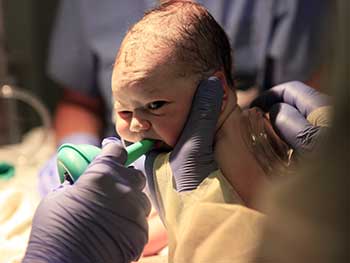Harmed at Birth: Brachial Plexus Injuries
 Having a baby is truly a blessed event for most couples. So very many times nature takes its course, with the result a healthy child. But even when no difficulties are expected, complications can occur at the last moment. Sometimes these complications can result in birth injuries. Brachial plexus injuries and palsies are one set of possible problems.
Having a baby is truly a blessed event for most couples. So very many times nature takes its course, with the result a healthy child. But even when no difficulties are expected, complications can occur at the last moment. Sometimes these complications can result in birth injuries. Brachial plexus injuries and palsies are one set of possible problems.
Brachial plexus birth palsy (BPBP) is not something that often arises in everyday conversation. Yet, estimates are that as many as three out of 1,000 infants are born with some sort of brachial plexus injury. This grouping of injuries can result in a lack of sensation, function, and movement in the affected shoulder, arm, wrist, or hand. The damage, unfortunately, can last for a lifetime in some children.
What is the Brachial Plexus, and How is it Injured?
On each side of the human body is a group of nerves known as the brachial plexus that enables the hand, wrist, arm, and shoulder to “talk” with the spinal cord, facilitating movement. Any injury to this network of nerves means that muscular function is impaired. Thus, it can be problematic to lift the arm, bend the arm, straighten the arm, or lower it. In such cases, consulting a Baltimore spinal injury lawyer can be crucial for understanding your legal options and ensuring proper care and compensation for your injuries. Exactly which motions are impaired depends on the variety and location of the brachial plexus damage. Types of nerve trauma are:
- Neuropraxia: the nerve is stretched, which damages it.
- Neuroma: injury to the nerve creates scar tissue, which interrupts the signal from the nerve that guides the muscles.
- Rupture: the nerve is torn but not at the spinal cord attachment location.
- Avulsion: the nerve is torn from the spinal cord.
The brachial plexus complex of nerves can be injured so that the following conditions occur:
- Erb’s palsy. Shoulder and arm movements become problematical because of damage to the upper brachial plexus nerves.
- Klumpke’s palsy. Wrist and hand movements become problematical because of damage to the lower brachial plexus nerves.
- A global palsy, due to both upper and lower brachial plexus nerve damage. Lack of sensation plus little to no movement in the hand, arm, or shoulder is often the result.
What are the Symptoms of BPBP, and How is it Diagnosed?
BPBP symptoms can vary quite a bit because the range of injury and the injury’s location fluctuate widely. For example, Erb’s palsy commonly presents itself with an inwardly-turning, stiff arm that ends in a bent wrist and extended fingers. If the nerve damage is severe, the arm can be limp or even completely paralyzed. In the case of Klumpke’s palsy, the fingers and hand on the affected side may operate even though the movement of the arm is limited. Also, the arm may position itself in a different fashion than with Erb’s.
The first symptoms that are noticed, often at birth but sometimes afterwards, are:
- A lack of movement in the hand, upper, or lower arm
- An arm that is unusually pressed to the body, or bent at the elbow
- A hand with a lessened ability to grip
- The absence of the Moro reflex, which is an involuntary response at birth to certain stimuli.
In the presence of symptoms, common diagnostic procedures such as assessing the Moro reflex, performing a physical exam, and obtaining X-rays of the injured area will usually be done. Certain specialized tests that might be performed include a nerve conduction study, which measures how far electrical signals travel on the nerves, and an electromyogram, which gauges muscle problems resulting from the nerve complex’s injuries.
How Are Brachial Plexus Birth Injuries Treated?
At times, neuropraxias and similar mild injuries can be resolved with noninvasive treatments such as massage, stretching, and physical therapy. More serious injuries such as torn nerves (rupture and avulsion) often necessitate surgical intervention. But do not be fooled—a case that initially seems mild, but does not respond to treatment within the first 90 to 180 days, may end up requiring more intensive treatments. If the nerve injury does not heal, then surgery could be on the table, even for a seemingly “mild” BPBP.
Continuing rehabilitation, along with splints and braces, can also assist in the infant’s recovery. But if the injury does not resolve itself, a lifetime of special and ongoing treatment for a BPBP can mean upwards of $1 million.
How Can the Brachial Plexus Become Injured?
Thankfully, many infant deliveries turn out just fine, but plenty of things can go wrong at the last minute, meaning the doctor or other medical personnel must intervene to assist with the delivery. If excessive force or stretching resulting from vacuum extraction or forceps is used, infants can sustain brachial plexus nerve damage.
Other birth circumstances can also translate into a greater likelihood of brachial plexus nerve damage:
- Fetal macrosomia, or delivering an infant of unusually large size and weight
- Feet-first (breech) delivery
- Insufficient development of the infant’s neck muscles
- Obesity in the mother
- Diabetes in the mother
- Infant shoulder dystocia, meaning that the infant’s shoulders get “stuck” during the birth process.
The latter situation, infant shoulder dystocia (a common cause of brachial plexus nerve injury), can damage the nerve complex in the following manner. In an effort to deliver the baby and avoid birth complications, the doctor or other medical personnel can employ too much force in the process. The issue of too much force can occur even if no outside or artificial means, like vacuum extraction or forceps, is employed to help along the birth process.
With an unusually large infant, occasionally a C-section (caesarean section) is required. In some situations where a C-section should have been performed but was not, a case could possibly be made that any brachial plexus damage suffered by the infant was due to malpractice.
Birth Injury? Let “The Injury Lawyer” Help You
An experienced medical malpractice attorney will be able to listen to the facts of your case, conduct a thorough investigation, and help you devise a legal strategy for obtaining compensation for your child’s injuries. While no amount of money will restore the lost or diminished function caused by a birth injury, compensation can help defray the costs of ongoing medical care, physical rehabilitation, medication, loss of function, special equipment and appliances and other costs that cause financial hardship for the family. If negligence or medical malpractice caused the brachial plexus birth injury, consulting with a Baltimore birth injury lawyer can be a crucial step to understand your rights. You have a right to hold the negligent parties responsible and recover damages to which you may be entitled under Maryland medical malpractice law.
The law offices of Maryland attorney Steven H. Heisler stand ready to help you. Interested on more information on whether you have a valid medical malpractice claim? Contact Baltimore medical malpractice lawyer Steven H. Heisler today for a free case consultation at (410) 625-4878, or use our online contact form.

Attorney Steve Heisler
Steve Heisler decided in 1996 that he was going to focus his law practice exclusively on injury cases. Since then, he has been representing injured people against insurance companies, disreputable medical practitioners and Big Pharma, and doing it with compassion, honesty and level-headed rationality. [ Attorney Bio ]

